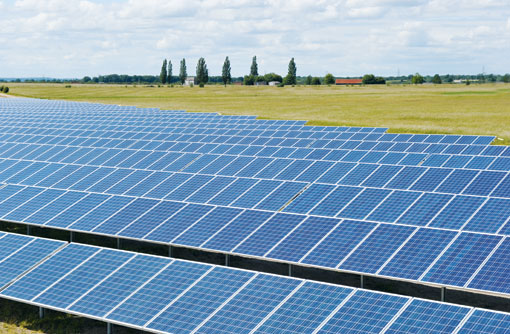Where now for farm-scale solar power?

The government’s recent move to slash Feed-in Tariffs for large-scale solar has halted many farm-based projects, but does not necessarily mean a premature end for solar energy in agriculture.
Clearly the 70% reduction in tariffs for photovoltaic systems above 50 kilowatts from 1 August makes many promising projects too expensive. It’s all the more unhelpful that it was announced just 10 months after Feed-in Tariffs were introduced to stimulate the uptake of renewables by businesses, individuals and communities. This has given the finance sector second thoughts about backing renewable energy projects. But opportunities still exist; and more will open up in future.
Surviving at present levels
The tariffs have been left intact for solar systems under 50kW; at least until the so-called “comprehensive review” due to take effect from April 2012. The south-facing roof of a 750 square metre barn, for example, could accept a photovoltaic system of about 50kW. If well designed and sourced, this should still make a 10% annual return for 25 years on the investment of something under £150,000.
The reduced tariffs for larger systems will inevitably make most projects over 50kW uneconomical. However, there will be isolated exceptions. The best projects – in higher sunlight areas of southern England with plenty of on-site electricity use – can still achieve annual returns up to 4%. That won’t get a funder excited, but may be enough to make a project viable when combined with other factors, such as planning conditions for related developments.
The pendulum swings
Feed-In Tariffs were introduced as part of a portfolio of policies to help the UK meet its 2020 obligation, under an EU directive, to deliver 15% of our energy from renewables. The government’s plan to meet this target suggests that 31% of UK electricity will come from renewables by 2020 – up from under 10% today. Even the government acknowledges how challenging this growth rate is.
The cut-back of the solar tariffs is a direct consequence of the spending review and budgetary constraints until 2014. By that time it is likely we will have fallen short of the EU’s interim targets for 2011-12 and 2013-14. My prediction is that the government will then find itself needing to maximise the uptake of any renewable source it can lay its hands on.
Solar PV has proved to be the most “deployable” of all, showing the fastest uptake whenever appropriate incentives are introduced – not just under the Feed-In Tariffs, but the Low Carbon Buildings Programme before it. When the government finds itself needing to accelerate the growth of renewable capacity in three years’ time, a quick and easy option will be to reinstate viable tariff levels for large PV systems or support them with multiple Renewable Obligation Certificates (ROCs) under the Renewables Obligation.
This doesn’t mean they would get back to the level of 30.7p/kWh that large systems currently enjoy, as continuing cost reductions mean that good returns should be possible at lower incentive levels in future.
Some progressive landowners are pressing on despite the tariff reduction to apply for planning approval anyway. There is a good chance that consents with three or five-year validity can be exploited in years to come.
Towards ‘grid parity’
Thankfully, life is not all about incentives and government action. While traditional energy is getting dearer, most renewables have declining costs, so the need for incentives will reduce over time.
Solar PV has the highest rate of price reduction. Installed costs for large systems have fallen by half in the past four years to about £2m per megawatt. The main component, the solar cell, is a semiconductor device, just like a computer chip, so costs can carry on declining as volumes rise.
Grid parity is solar power’s Holy Grail – the point where the rising costs of traditional energy and the falling costs of renewables cross over. A recent report by Ernst & Young concluded that “Grid parity with retail prices is expected to be achieved in the UK by 2020 without subsidy for non-domestic, on-site installations.” This means that, at the best sites, solar systems will be viable within a decade, even without Feed-In Tariffs.
Clearly, the next couple of years will not be as exciting for solar energy on farms as we had all hoped. But the juggernaut is coming and one poor decision by government won’t stop it.
Philip Wolfe is chairman of solar specialists Ownergy. He was previously director general of the Renewable Energy Association and chief executive of BP Solar
